Fence Landscaping Ideas: What to Plant Along Fence Line

Planting shrubs and creeping plants along a fence line is ideal for covering a bare or unsightly fencing system. Fence landscaping ideas can include planting evergreen shrubs to hide the fence throughout the year. Or you can plant flowering shrubs to add color, fragrance, and greenery from spring through fall. Additionally, you can landscape along a fence using climbing plants to grow behind the foliage of other shrubs.
What are the best plants to grow along a fence line? This article has pictures and descriptions of some of the best plants for covering a fence. So whether your front or backyard gets plenty of sunshine or is in the shade, you will find fence landscaping ideas in this article.
Why Landscape Along a Fence Line?
Planting shrubs and flowering climbing plants add color and texture, helping to remove harsh lines from front or back yards. As well as covering a stone, brick, metal or wooden fence, these tall shrubs help increase privacy, reduce maintenance, and add to the overall aesthetics of your yard.
Landscaping along a fence line is an excellent way to create a more visually appealing and inviting outdoor space. It can also help to reduce noise from a busy street or neighbor’s yard. Additionally, planting along a fence line can provide privacy and security for your home—especially if you plant thorny bushes or shrubs with dense foliage.
The Best Plants for Fence Line Landscaping
The best plants for landscaping a fence line depend on the amount of sunlight and shade in your yard and soil type. Also, it would be best if you bought shrubs and climbing plants suitable for your USDA growing zone. The best fence line plants should be low-maintenance with minimal watering requirements.
Choosing plants suitable for fence line landscaping depends on the type of fence and your goals. For example, shrubs are ideal for wooden fences as you can train them to grow along the fence. However, if you want climbers, you may need to install a trellis or other type of support for the plants.
It’s good to note that shrubs growing along a fence line may need additional care due to constricted space at the roots. Therefore, it’s a good idea to dig in rotted manure or compost and ensure that the soil is always moist. Also, depending on light levels, you may need to choose shrubs for full sun or partial shade.
Fence Landscaping — the Best Plants to Grow Along a Fence
When planning a fence landscaping project, choosing the right plants is key to ensuring it looks good for many years. There are plenty of options when selecting plants for your fence line. However, you should choose ones that require minimal upkeep and care.
Let’s look at some of the best shrubs for planting along a fence line.
Shrubs to Plant Along a Fence Line
Boxwood (Buxus)
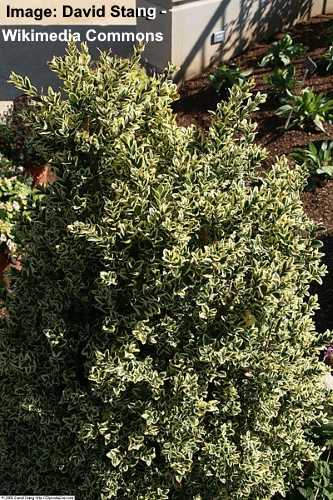
Variegated English boxwood (Buxus sempervirens ‘Variegata’) is tall bushy shrub that grows between 5 and 8 ft. (1.5 – 1.8 m) tall and wide and is ideal to plant along fence line
Boxwood is a group of popular evergreen shrubs that are an excellent choice for fencing and wall landscaping. Boxwood shrubs have a dense growth habit with foliage consisting of small, glossy green leaves. These landscaping shrubs are easy to trim, prune, and maintain in a formal front or backyard.
Boxwood shrubs can have rounded shapes or be tall, columnar plants. Depending on the species, the shrubs range in height from 1 to 15 ft. (0.3 – 4.5 m) tall and 1 to 5 ft. (0.3 – 1.5 m) wide. The dense evergreen foliage is suitable for screening and improving privacy in your garden.
Boxwood shrubs are suitable for USDA zones 5 to 9.
Related reading: Evergreen shrubs for growing in a front yard.
Viburnum Shrubs

Leatherleaf viburnum (Viburnum rhytidophyllum) is an evergreen flowering shrub that grows between 6 and 10 ft. (1.8 – 3 m) tall and looks great when planted along the fence line
Many varieties of viburnum shrubs are perfect for planting along a fence line. The evergreen or deciduous shrubs are known for their sweet-smelling flowers, oval to lanceolate leaves, and clusters of showy ornamental fruits. Additionally, deciduous viburnum shrubs have spectacular fall colors that range from purple to red tones.
Viburnum flowers are typically round snowball-like blooms or flat-topped clusters of small flowers similar to hydrangeas. The fragrant flowers range in color from white to pink and greenish-yellow. The attractive landscaping shrubs grow 5 to 10 ft. (1.5 – 3 m) tall. Depending on the cultivar, they are suitable for growing in USDA zones 2 to 11.
Their upright growth makes the shrubs perfect for lining a fence, front-of-house foundation planting, or informal hedge.
Clusia (Clusia guttifera)
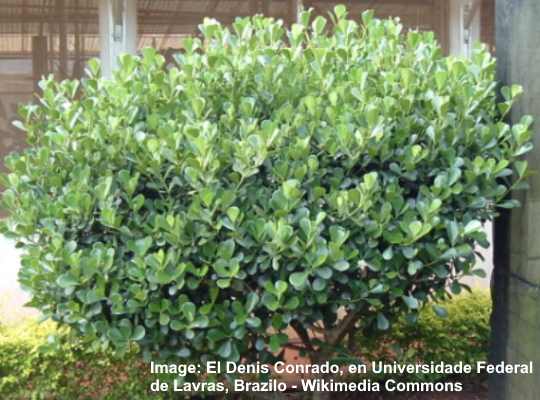
Clusia guttifera (small leaf clusia) is a popular hedge plant in tropical countries, and being low maintenance it’s suitable when looking for fence covering ideas
Clusia shrubs are ideal fence line landscaping plants due to their thick, leathery leaves and dense foliage. The thick, paddle-shaped, or oval leaves create a dense privacy barrier or thick hedge. However, the evergreen fence line shrubs rarely flower. On the other hand, they are fast-growing and require little maintenance.
Clusia hedge plants can grow up to 25 ft. (7.5) tall, making them ideal for increasing privacy along a wooden paneled fence. However, with annual pruning, you can keep the height of clusia shrubs to a more manageable 5 to 6 ft. (1.5 – 1.8 m) tall.
Clusia shrubs are an attractive addition to any landscape to cover a fence or a wall in USDA zones 10 and 11.
Related reading: The best shrubs to grow in Florida.
Podocarpus Shrubs (Podocarpus macrophyllus)
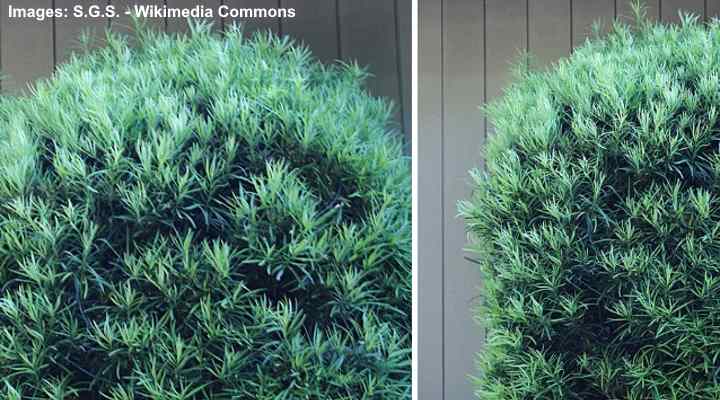
Podocarpus macrophyllus shrubs are one of the best plants for fence line and can be trimmed to control their height
Podocarpus shrubs look spectacular growing along a fence line, brick wall, or chain-link fencing system. The attractive evergreen shrubs add greenery and color to a front or backyard. The easy-care shrubs have dark green, linear leaves that emerge a stunning bronze-red color in spring and fall.
Podocarpus is an evergreen conifer that grows 10 to 15 ft. (3 – 4.5 m) tall and up to 6 ft. (1.8 m) wide.
Thriving in USDA zones 7 to 10, the bushy shrub is ideal for a hedge, accent plant, or fence line landscaping. You can plant the drought-tolerant shrubs in full sun or shade in fertile, well-drained soil.
Chinese Fringe Flower (Loropetalum chinense)
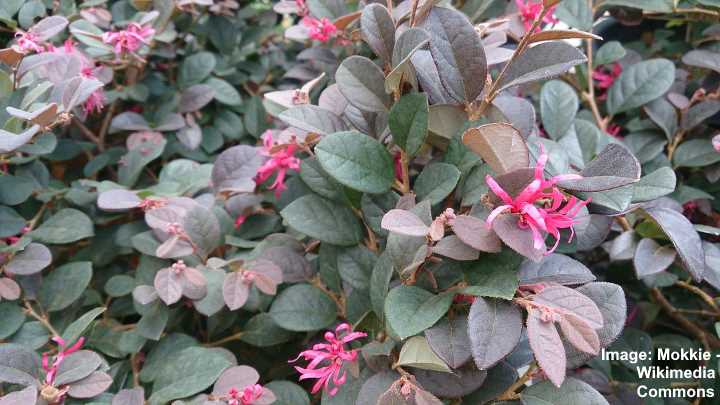
The Chinese fringe flower shrub has colorful foliage and some cultivars have deep pink flowers that look stunning when landscaping along fence
If you want fence line landscaping ideas with white or pink flowering shrubs, then Chinese fringe flower shrubs are a great choice. These ornamental shrubs are famous for their clusters of creamy-white or deep pink flowers consisting of wiry, spidery petals measuring 1” (2.5 cm) long. Its compact, upright growth makes the evergreen shrub perfect for fence lines.
The Chinese fringe flower shrub thrives in USDA zones 7 to 9, growing 5 to 6 ft. (1.5 – 1.8 m) tall and wide. In addition to being an excellent choice to cover a fence or stone wall, its attractive foliage and decorative flowers make it an ideal accent plant, specimen shrub, or container plant.
Camellias

Camellia is a flowering shrub that has many hybrids and cultivars and can grow higher than the fence to add more privacy
Camellia shrubs are stunning flowering evergreen bushy plants for the fence line with striking white, red or pink blooms. The showy single or double flowers contrast nicely with the luscious oval green leaves. Many camellia shrubs bloom in fall and winter, making them perfect for adding color and vibrancy to disguise an unsightly fence late in the season.
These hardy plants perform well in partial sun or full shade, making them great for fence line landscaping. The shrubs grow 5 to 8 ft. (1.5 – 2.4 m) tall, depending on the cultivar. However, there are dwarf camellia varieties for compact gardens that don’t grow taller than 3 ft. (1 m).
Camellia shrubs have showy, fragrant blooms in shades of red, pink, and white and their dense foliage makes them perfect for privacy screening along fences in USDA zones 6 to 9.
Azaleas (Rhododendron spp.)
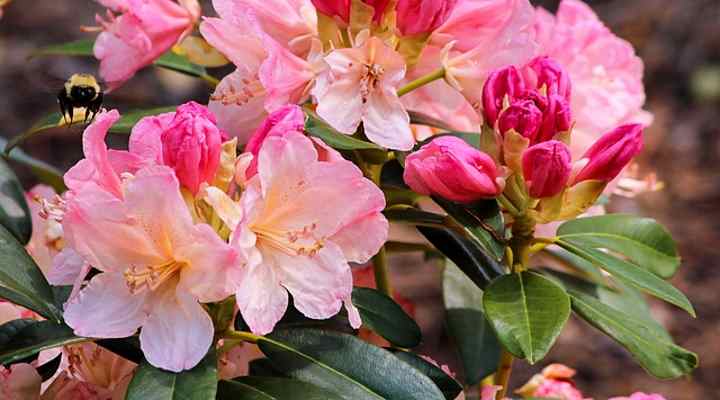
Flowering azalea shrubs include many cultivars that give stunning color along fence line
Azaleas are beautiful flowering shrubs with showy clusters of colorful blooms that come in shades of pink, purple, white, yellow, orange and red. Azaleas bloom in mid-spring with attractive trumpet-shaped flowers in large clusters. Their shrubby form, showy flowers, and thick, leathery leaves make azaleas perfect for fence line planting to add a splash of color to a yard.
Azalea shrubs for front or backyard fence lines grow 4 to 6 ft. (1.2 – 1.8 m) tall. They thrive in USDA zones 4 to 9; however, you should check the individual cultivar as some are cold-hardier than others. Beautiful azaleas are well-suited as specimen plantings, informal hedges, or mass planting along a foundation.
Climbing Roses (Rosa)

The are many stunning hybrids of climbing roses in many color varieties to suit any fence landscaping idea
Climbing roses are some of the most spectacular flowering shrubs you can use in fence line landscaping. With their showy flower clusters, the blooming shrubs have vigorous growth and thorny branches and repeat blooming throughout the season. In addition, the long, woody stems are easy to train to grow against a fence or wall.
Climbing roses grow 5 to 20 ft. (1.5 – 6 m) tall and up to 6 ft. (1.8 m) wide. To enjoy their wonderful, fragrant blooms, plant climbing roses along a fence in full sun in USDA zones 5 to 9.
Hydrangea

When looking for fence covering ideas, bigleaf hydrangea/mophead hydrangea (Hydrangea macrophylla) shrubs are great choice to hide unsightly fence with their stunning blooms
Hydrangea shrubs are another popular choice for fence line landscaping. The cold-hardy deciduous shrubby plants have showy clusters of long-blooming flowers. Some hydrangeas have mophead flowers with round flowerheads, and others have delicate lacecap, flattened clusters. The flowers of the deciduous shrubs can be as large as 6” to 12” (15 – 30 cm) across.
Hydrangea shrubs make excellent solutions to landscape a fence line. The fast-growing plants thrive in USDA zones 3 to 8 in full sun or partial shade.
Cherry Laurel (Prunus caroliniana)

Carolina cherry laurel is a great choice for hedges or privacy and to plant along fence line and can be pruned to maintain manageable size
Cherry laurel is an evergreen shrub with dense foliage, making it a perfect choice for defining a garden border along fence lines. This large evergreen broadleaf shrub is identified by its glossy green foliage, clusters of sweetly scented white flowers, and reddish-purple berries.
The landscaping shrub grows 20 to 30 ft. (6 – 9 m) tall and up to 25 ft. (7.5 m) wide. You can plant the tall shrub to increase privacy in a backyard, grow a living fence, plant it for screening, protect a yard from wind and noise, or grow it as a shrub border.
Suitable for USDA hardiness zones 7 to 10.
Photinia ‘Red Robin’ (Photinia x fraseri ‘Red Robin’)
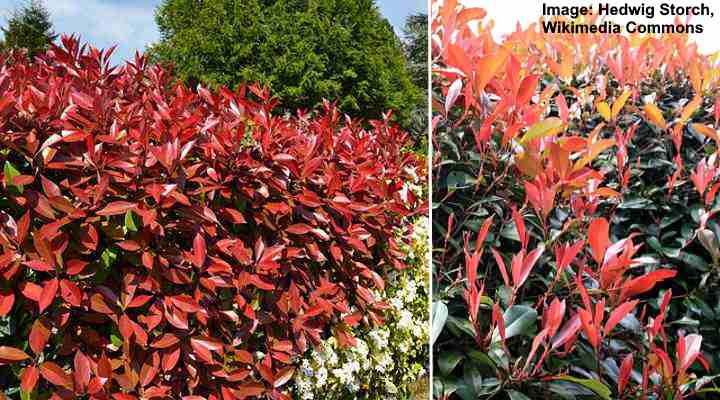
Grow Photinia ‘Red Robin’ bushes as a fence cover for their beautiful new red leaves that gradually turn green as they mature
The photinia cultivar’ Red Robin’ is a compact shrub ideal for creating a living fence. The evergreen shrub has glossy, dark green foliage that emerges bright red in spring. Additionally, clusters of five-petalled white flowers also bloom in spring, followed by bright red berries. Its leathery leaves are elliptic to oval and provide year-long screening.
The fast-growing shrub grows 9 to 12 ft. (2.7 – 3.6 m) tall and wide. Plant it to hide a fence or brick wall or use it to create a natural screen or hedge. The shrub thrives in USDA zones 7 to 9.
Firethorn (Pyracantha)
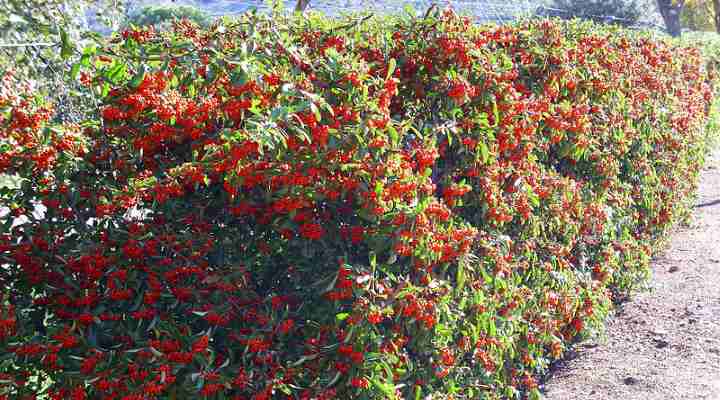
Firethorn is a thorny shrub that can be used as a fence landscaping idea due to its evergreen foliage, ornamental red berries, and white flowers
Firethorn is a group of low-maintenance evergreen shrubs to define property lines, create an impenetrable screen or hedge, or use it as a security barrier. The thorny shrubs have glossy green foliage and clusters of white spring flowers followed by bright red, yellow, or orange berries that persist through winter.
Firethorn grows 6 to 16 ft. (1.8 – 5 m) tall and up to 8 to 18 ft. (2.4 – 5.4 m) wide. Plant the fast-growing shrub along a wall or fence line in USDA zones 6 to 9.
Japanese Spindle (Euonymus japonicus)

The dense foliage of Japanese spindle makes it one of the best plants for fence line
The Japanese spindle plant is an evergreen shrub commonly used as a hedge or border shrub. The ornamental features of this attractive shrub are its lush foliage and showy red, pink, or golden yellow round fruits. The easy-care, versatile plant grows well in containers on patios, driveways, or along a fence line.
The Japanese spindle shrub grows 10 to 15 ft. (3 – 4.5 m) tall, making it ideal for increasing privacy in your yard. It thrives in USDA growing zones 6 to 9 and tolerates heavy shade and full sun conditions.
Indian Hawthorn (Rhaphiolepis indica)
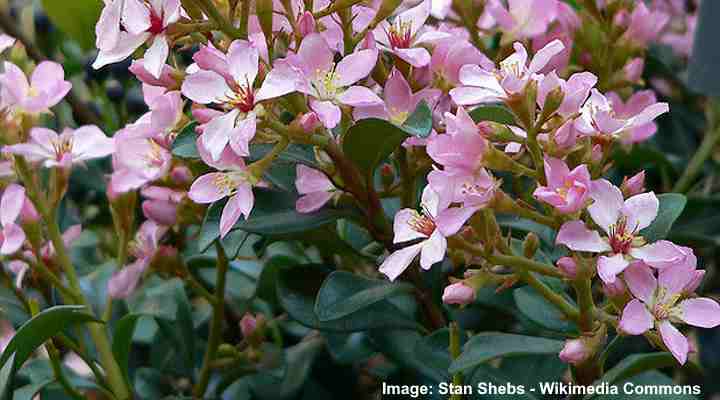
Indian Hawthorn is an evergreen flowering shrub with pink or white flowers. This image shows Rhaphiolepis indica cv. ‘Ballerina’
Indian hawthorn is a perfect addition to any fence line landscaping project. This evergreen shrub produces attractive pinkish crab-apple-like flowers in spring, bluish-black berries, and leathery lanceolate deep green leaves. It usually grows up to 4 – 6 ft. (1.2 – 1.8 m) tall and wide. Thanks to its compact habit and rapid growth, Indian hawthorn makes an ideal living fence, hedge, or privacy screen.
Indian hawthorn performs best in full sun or partial shade in USDA zones 8 through 10. Its dense growth and compact habit make it ideal for small spaces, containers, or covering a low fence.
Common Privet (Ligustrum vulgare)
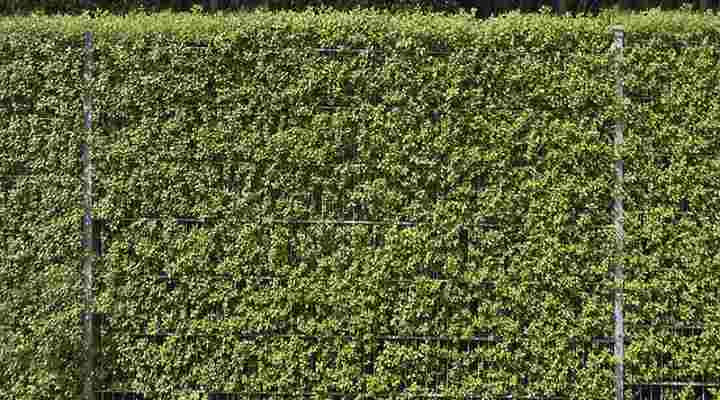
Choose privet shrubs if you want a fast growing privacy hedge to cover unattractive fence
Common Privet is an excellent shrub if you are looking for a residential fence line landscaping solution. This fast-growing evergreen shrub has densely growing, lush foliage providing screening and privacy for a front or backyard. Also called wax-leaf, wild privet, or amur, the hedge plant thrives in USDA zones 4 to 7.
Common privet prefers average soil moisture and thrives in full sun or partial shade. The tall fence line plant grows 10 to 15 ft. (3 – 4.5 m) tall and wide. Ornamental features of the deciduous bushy shrub are its clusters of white, star-shaped flowers, lanceolate leaves, and glossy black berries.
Creeping Plants and Vines for Fence Line Landscaping
Creeping and climbing plants and vines are an excellent choice for adding vibrant, lush greenery to any landscaping ideas along a fence line. Vines and creeping plants can add an additional element to a natural living fence with colorful foliage or colorful, fragrant blooms.
Virginia Creeper (Parthenocissus quinquefolia)

Virginia creeper vines quickly cover unsightly walls and fences with their fast growth rate
Virginia creeper is a fast-growing vine perfect for covering a fence, wall, or unsightly garden structure. Identifying features of this vining plant are its palmate leaves with five leaflets, clusters of small greenish-white flowers in summer, and bunches of blue-black berries. In the fall, the foliage turns spectacular shades of crimson red and deep burgundy.
Virginia creeper is an excellent choice for a natural fence line landscaping project. The fast-growing climber grows 30 to 50 ft. (9 – 15 m) tall and thrives in USDA zones 3 to 11. The hardy vine tolerates full sun or partial shade and prefers moist soil.
Star Jasmine (Trachelospermum jasminoides)
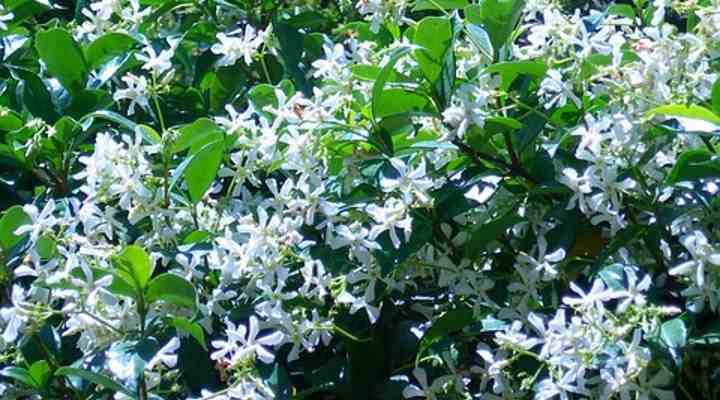
The fragrant white flowers of star jasmine and its climbing nature make it ideal to cover walls and fences in warmer zones
Star jasmine is an eye-catching vining shrub that blooms with masses of pinwheel white flowers in late spring. The climbing vine is ideal for covering privacy fences or concrete walls. The vine also features glossy, dark green leaves and twining stems and grows up to 20 ft. (6 m) tall.
Star jasmine will quickly climb over a fence, arbor, pergola, or in USDA zones 8 to 10 and performs best in full sun or partial shade. The evergreen vine is drought tolerant and requires little maintenance once established.
Honeysuckle (Lonicera)

You can use the hardy flowering honeysuckle as a trellis plant or climber to cover unsightly fences or walls
Honeysuckle is a deciduous climbing plant perfect for adding visual interest and color to your garden landscape. With their beautiful, fragrant flowers, honeysuckle vines beautify any fence, brick wall, or garden structure. The hardy vine blooms throughout summer through fall. It’s famous for its slender trumpet-like flowers emitting heady fragrances.
If you are looking for a vining plant to provide privacy screening along fences or walls, Honeysuckle is a perfect choice. The fast-growing vines with fragrant orange, red, yellow, and white flowers can grow up to 30 ft. (9 m) tall and thrive in USDA zones 4 to 9.
Related articles:
